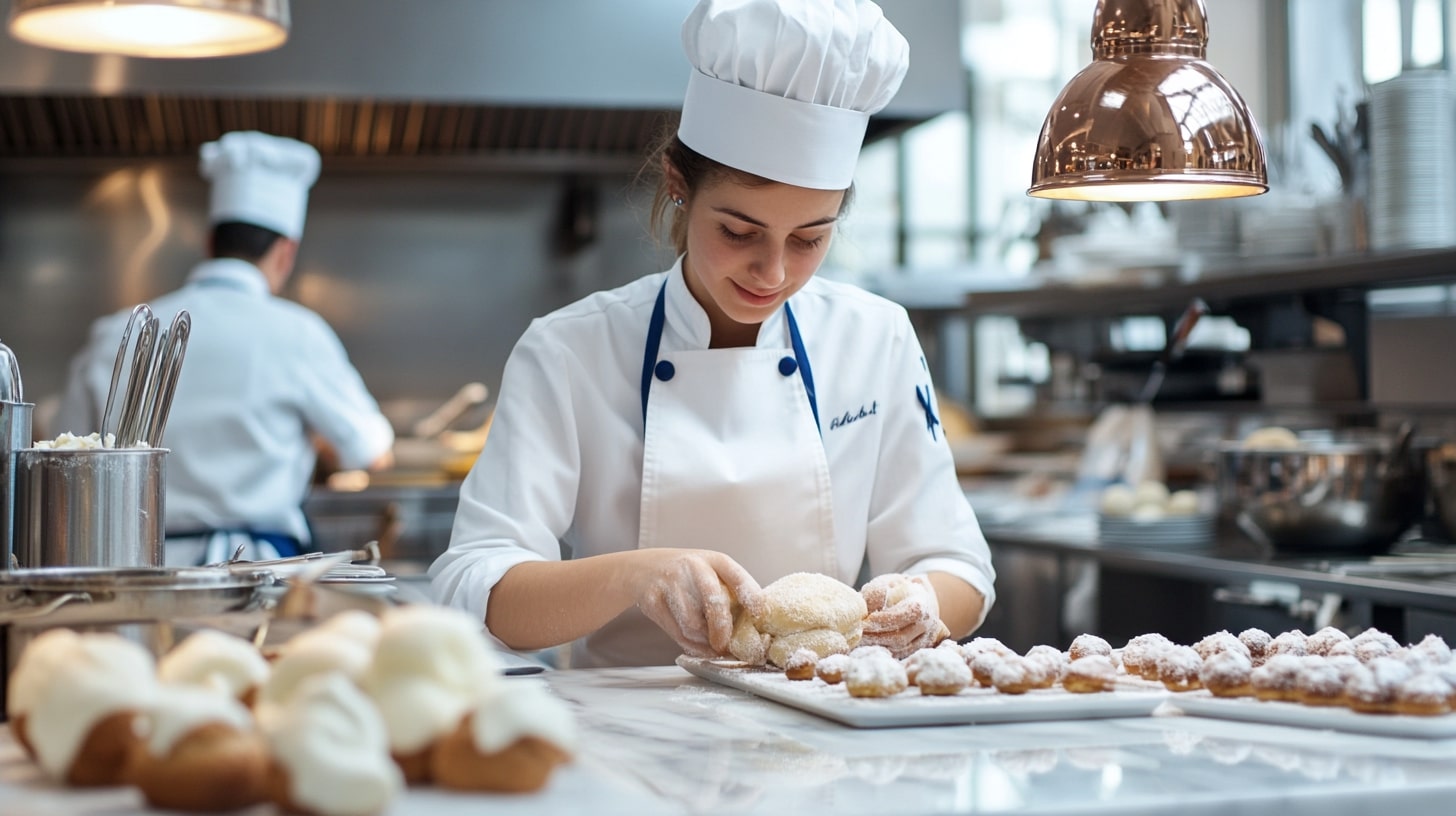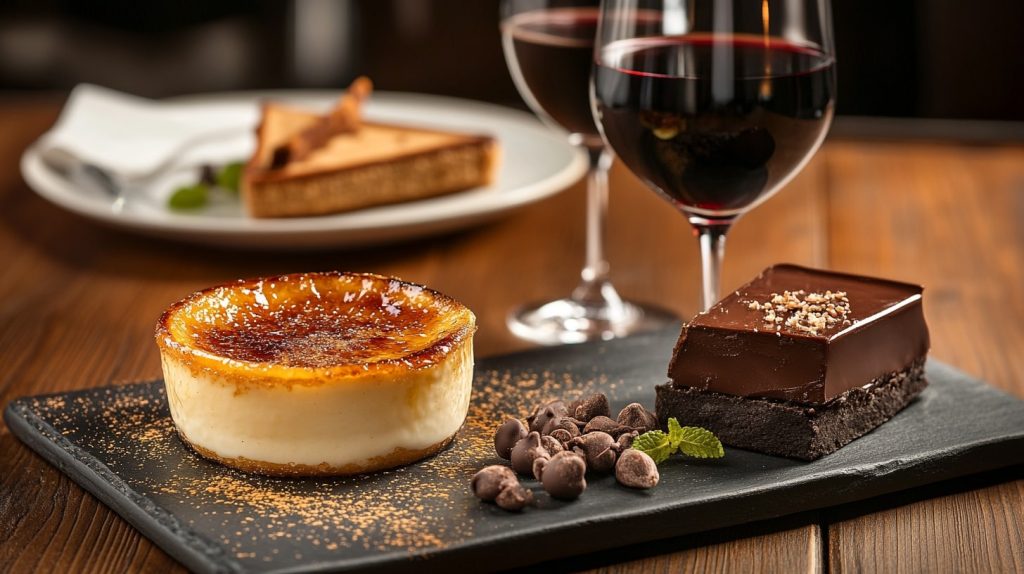
French patisserie is a world of its own, where culinary artistry meets a rich cultural heritage. Together, we’ll delve into the origin of the term “patisserie” and uncover how it distinguishes itself from the average bakery. We’ll explore the delightful realm of viennoiserie, those buttery, flaky pastries we all love.
Discover famous French pastries that have captured hearts globally and learn about the prestigious patisserie schools that nurture the next generation of pastry chefs. Join us on a journey through French pastry culture, tailored for those with a taste for the exquisite and a passion for France. Allons-y!
The rich history of 'patisserie'
French culinary terms can sometimes be confusing. The French term “pâtisserie” refers to both the art of making pastries and the shop where these sweet creations are sold.
It is distinct from a “boulangerie,” which focuses on bread, but more on this later. The term is derived from the Old French word “pastiz,” meaning cake, which comes from the Latin “pasticium,” meaning a type of dough or paste. Over time, the spelling evolved to “pâtisserie” in modern French, incorporating the circumflex over the ‘a’ to indicate the historical presence of an ‘s’ that has since been dropped.
Patisserie as a trade evolved significantly during the Renaissance period, when increased contact with the Italian and Spanish courts introduced the French to refined sugars and pastry techniques. By the 17th and 18th centuries, the popularity of these sweet delicacies rose among the French aristocracy, especially in Paris, with the maître patissier gaining prominence for their creative and elaborate desserts.
The 19th century saw further evolution as patisserie became more accessible to the public. Techniques and recipes were honed and standardized, largely due to the influence of Marie-Antoine Carême, a master pastry chef who elevated the craft to new heights. Carême’s innovative designs and techniques laid the foundation for modern patisserie, turning it into a respected culinary art form.
Today, patisserie is synonymous with excellence in pastry craftsmanship, emblematic of French culinary heritage. The trade’s fame has spread globally, with patisserie chefs revered for their technical skill and artistic flair.
What is the difference between a bakery and a patisserie?
A bakery and a patisserie may both offer delightful baked goods, but they differ in focus and specialization. A “patisserie” is a French pastry shop that specializes in sweet, decorative desserts such as cakes, tarts, and eclairs, embodying the pinnacle of culinary artistry.
A bakery, often referred to as a “boulangerie“, primarily specializes in French bread and simple baked items. This includes products like baguettes, pain au chocolat, and croissants. Bakers in these establishments are experts in the art of bread-making, often using traditional methods and high-quality ingredients. While a boulangerie can also offer pastries, these are generally less elaborate than those found in a patisserie.
The strict regulations in France maintain this distinction to preserve the integrity and specialization of both trades. Boulangeries, with their range of bread products, from traditional baguettes to rye loaves and sweet brioches, cater to everyday culinary needs rather than the luxurious indulgence typically found at a patisserie. This clear division ensures that both bakers and pastry chefs excel in their respective crafts, maintaining high standards and promoting the continued excellence of French culinary arts.

What's the difference between a patisserie and a viennoiserie?
As we have seen, “patisserie” refers to a variety of intricate, elegant cakes and pastries, such as mille-feuille, layered cakes, and fruit tarts, known for their sophisticated flavors and decorative presentations, often involving complex techniques like tempering chocolate, crafting sugar art, and perfecting delicate pastry shells. These creations represent some of the most iconic examples of french desserts appreciated around the world.
“Viennoiserie,” on the other hand, encompasses a different category of baked goods, inspired by Austrian techniques but perfected in France. This category includes flaky, buttery pastries such as croissants, pain au chocolat, brioche, and pain aux raisins. The key characteristic of viennoiseries is their use of yeast-leavened dough laminated with butter, which creates their signature light, airy texture with numerous flaky layers. The technique involves careful dough folding and temperature control to maintain the butter’s consistency, ensuring the dough layers separate beautifully during baking.
Viennoiseries are generally less sweet than patisseries and are often enjoyed as part of breakfast or a light snack. They are commonly sold in boulangeries throughout France, highlighting their role as everyday delights rather than elaborate desserts. While patisseries may offer viennoiserie items, their primary focus remains on creating sweet, elaborate pastries and desserts.
The development of viennoiserie as a staple in French boulangeries reflects a blend of culinary tradition and innovation, drawing from Austrian origins but adapted to French tastes and baking styles. This makes viennoiseries both a testament to historical influence and a key aspect of daily French cuisine.

The most famous French pastries
And now let’s discover some examples of world-famous French patisserie cakes! If you’ve ever traveled to France, you’ve probably seen countless shop fronts brimming with delightful sugary works of art. And whenever France is mentioned in magazines and documentaries, French patisserie is usually part of the topics, just after the Eiffel tower.
There are several iconic pastries that really stand out:
- Mille-Feuille: Also known as “Napoleon,” this pastry consists of multiple layers of delicate puff pastry filled with rich pastry cream and often topped with a layer of icing or fondant. The combination of crisp layers and creamy filling creates a delightful contrast in texture and flavor.
- Religieuse: This elegant pastry resembles a nun’s clothing, hence its name. It consists of two choux pastry puffs filled with flavored pastry cream (often chocolate or coffee) and stacked on top of each other. The puffs are glazed with fondant and decorated with piped buttercream, creating a beautiful and delicious treat.
- Opera Cake: A sophisticated layered dessert, the Opera Cake features thin layers of almond sponge cake soaked in coffee syrup, interspersed with layers of coffee buttercream and chocolate ganache. The cake is topped with a glossy chocolate glaze and often decorated with edible gold leaf or chocolate flakes.
- Paris-Brest: Named after a famous bicycle race, this pastry is shaped like a wheel. It consists of a ring of choux pastry filled with praline-flavored cream and garnished with sliced almonds. The Paris-Brest is known for its light, airy texture and nutty, caramel-like flavor.
and many more to discover…

How to become a patisserie chef ?
Becoming a patisserie chef involves a delicious blend of creativity, precision, and, of course, a sweet tooth. The journey often starts at renowned culinary schools known for their pastry programs. The most famous, Le Cordon Bleu in Paris, was established in 1895. It originally referred to the blue ribbon worn by members of the highest order of knighthood established by King Henry III in 1578, well-known for their lavish banquets. the Culinary Institute of America, and Ecole Lenôtre are also famed for turning enthusiastic bakers into expert pastry chefs. These schools offer intensive courses that cover everything from the basics of dough to the fine points of sugar art.
And what about ranks? Well, in the world of professional patisserie, they vary from commis patissier (junior pastry chef) to chef patissier (head pastry chef), each role demanding a higher level of skill and creativity. Climbing the sugary ladder really requires dedication, a flair for flavor, and an eye for exquisite design.
But what if whisking away to a pastry school in Paris isn’t yet in your immediate life goals? Fear not! The internet is your oyster (or should we say, your macaron shell)! With countless recipes and video tutorials available, anyone can whip up marvelous creations right at home. Who needs a fancy title when you can be the master of your own kitchen, dazzling friends and family with everything from homemade eclairs to the perfect chocolate ganache? Turn that oven on and let the baking adventures begin!

Conclusion
French pâtisseries and boulangeries are more than just places to buy dessert—they represent a tradition of craftsmanship, precision, and indulgence. From its historical origins to the delicate techniques and renowned patisserie shops, the world of French pastry is a delightful journey for any food enthusiast. Whether savoring a mille-feuille at a Parisian café or attempting to bake a Paris-Brest or brioche at home, exploring the world of pâtisserie and viennoiserie is a delicious journey worth taking.
Bon appétit !



